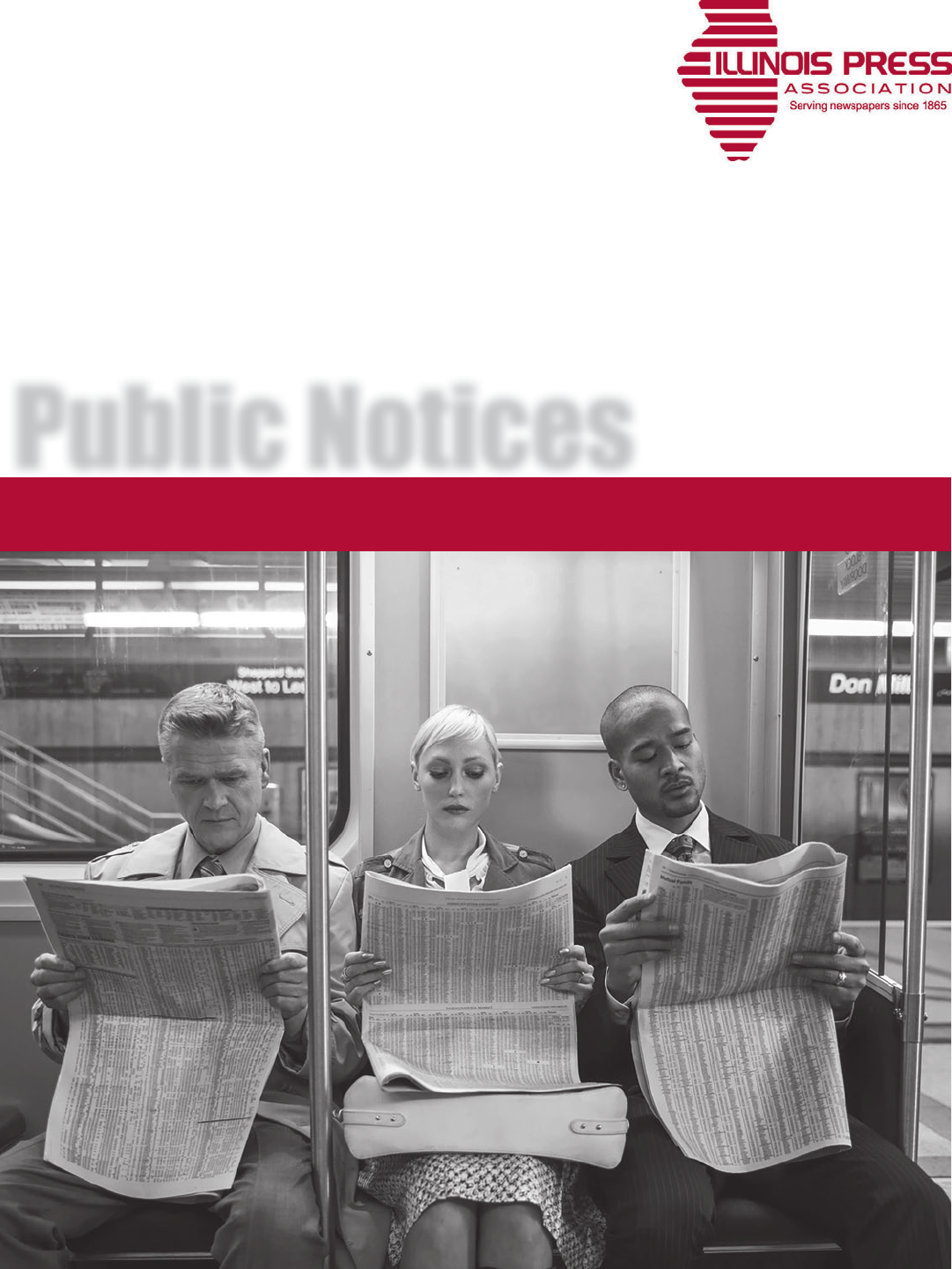
Public Notices
Best Practices and Resource Guide
August 2018
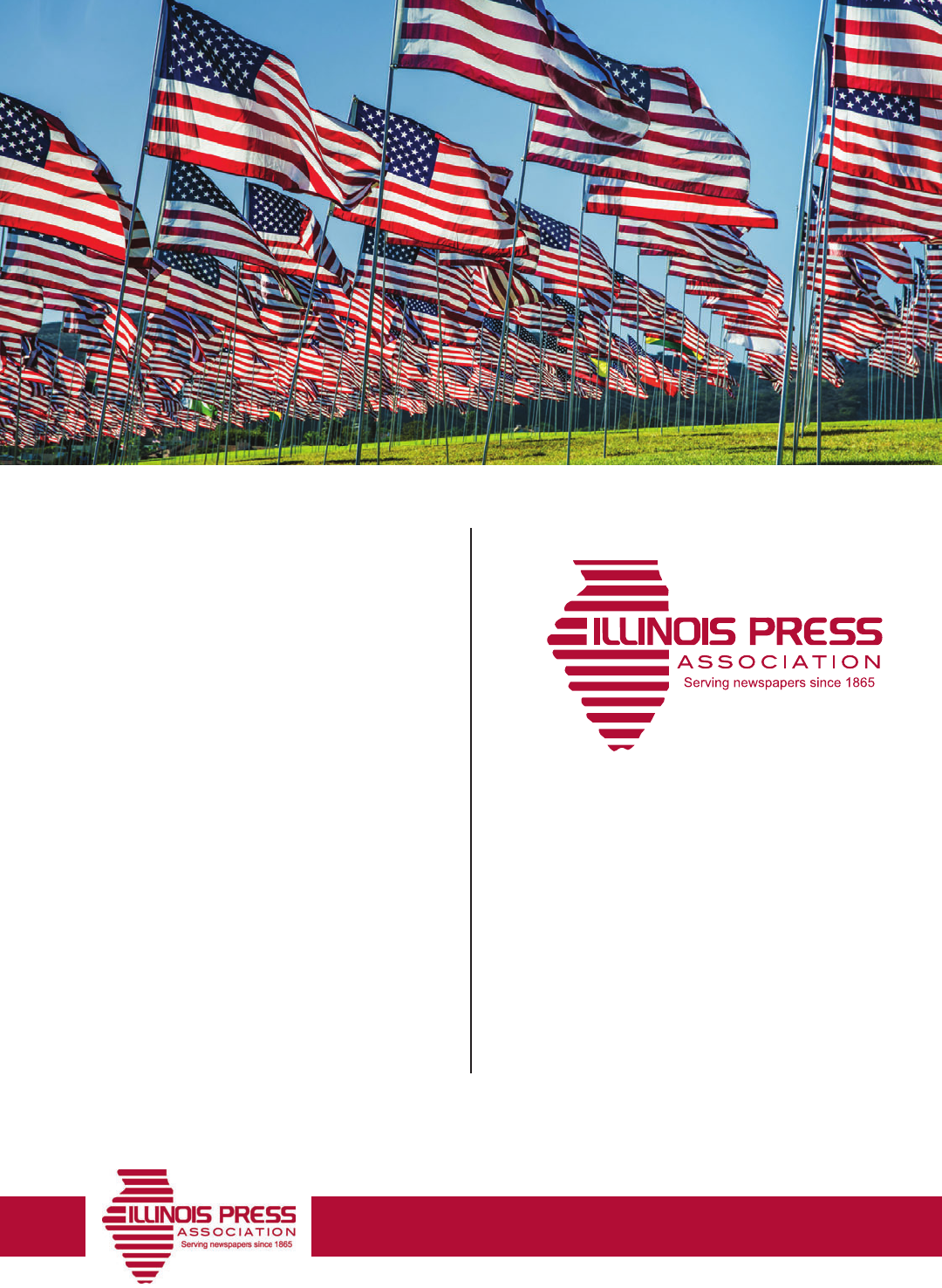
2
Best Practices and Resource Guide
Index
INTRODUCTION
BEST PRACTICES
Developing relationships
Promotion
Print
Online
Perspective
Talking Points Doc
RESOURCES
Illinois Compiled Statutes
Qualications for newspapers
FAQs
What to charge
Dierent types of notices
4
5
6
8
10
14
17
19
21
23
24
900 Community Drive
Springeld, IL 62703
Phone: 217-241-1300
Fax: 217-241-1301
www.illinoispress.org
www.publicnoticeillinois.com

3
Best Practices and Resource Guide
Introduction
When it comes to informing local people about local issues, nobody does it better than newspapers.
It’s important that our citizenry participate in our democracy by keeping a careful eye on government aairs. We
all have a civic responsibility to be engaged. Public notices are critical to that engagement process. Public notices
and an informed public guarantee government is there to serve the people, not the few in power.
Newspapers serve as an independent third-party to ensure that the public is informed in a timely manner and
that those notices are archived for public viewing at any time.
During every legislative session there is an attempt by some legislators to take public notices out of newspapers
and instead post them on the internet. At rst blush, it sounds like a great concept, as everybody goes to the web
and it would save local units of government the fee that newspapers charge for notices, but it’s not.
Granted, there is a nancial incentive for newspapers to continue to publish notices, but the bigger picture is that public notices are intended
to let citizens know about the goings-on in government. After all, notices are required by statute to ensure government transparency.
Certain legislators believe that since everybody has internet access, it’s the right thing to do. Would these notices appear on the state
transparency site, ITAP, or would they be posted on each unit of governments’ site? Keep in mind there are over 7,000 units of local
government in the state and the majority don’t have websites. So, if there is no website, where does the information go? Nowhere. And
not everyone has internet access.
Educating our readers on the value of public notices is one of our most important tools to protect the public’s right to know. We want you
to use this guide as a resource to ensure that public notices remain in newspapers.
SAM FISHER
President & Chief Executive
Ocer
ssher@illinoispress.org
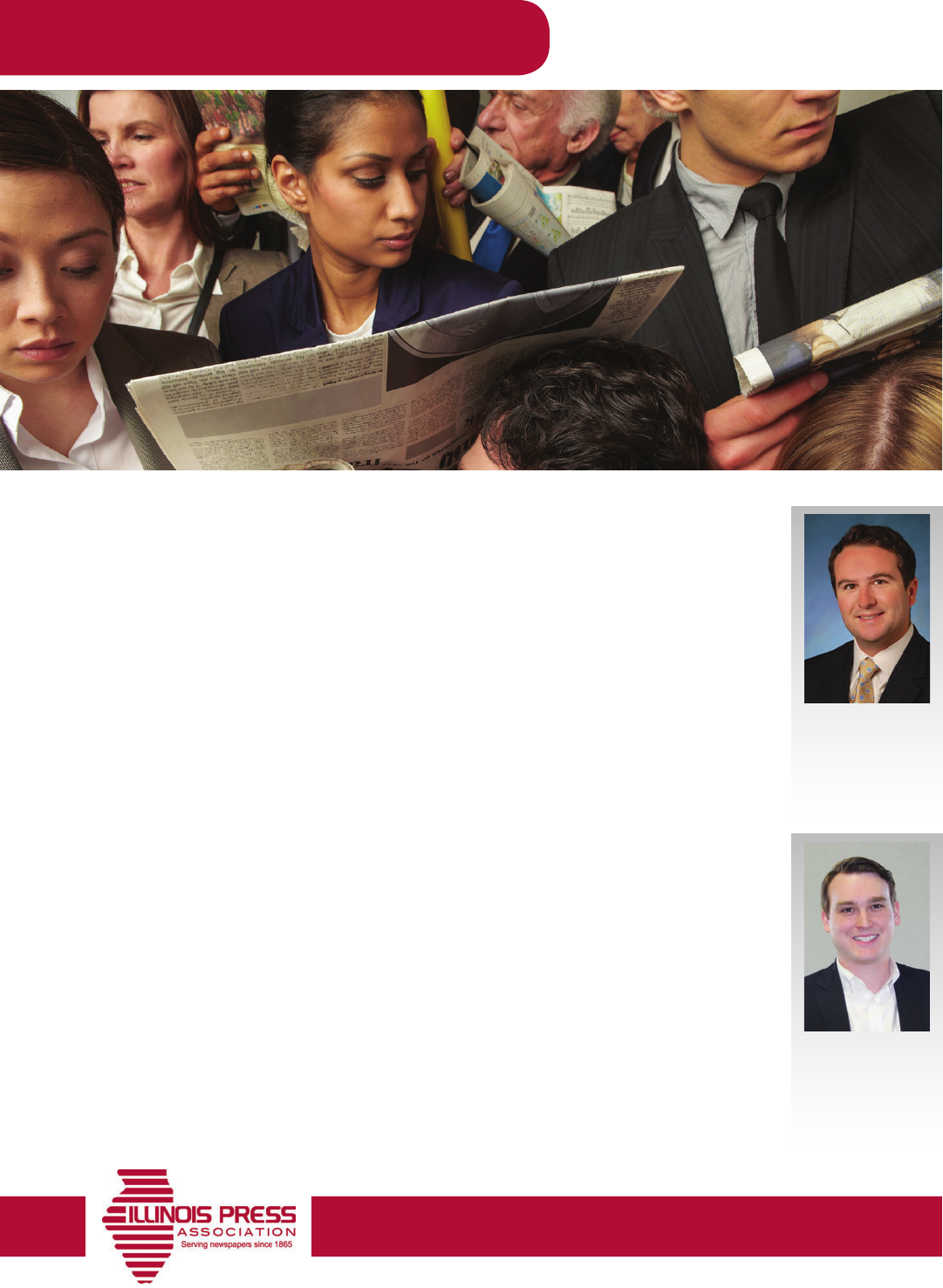
4
Best Practices and Resource Guide
Best Practices – Relationships
BUILD RELATIONSHIPS WITH DECISION MAKERS
More and more, we nd that many publishers and editors have a limited or no relationship with legislators. It
doesn’t look good when the only time newspaper leaders reach out to the legislators is when public notices are
threatened. The IPA Government Relations team is happy to assist you in building these relationships.
We encourage you to meet with your legislators several times a year to build that relationship. Saving public
notices is only one benet you’ll nd from meeting with your representatives.
This isn’t just a legislative issue. In recent years, local governments have led the charge to remove notices from
papers. Having a working relationship with local elected ocials is incredibly important. Policy makers, such as
these, include county board members, aldermen, school board members and county-wide elected ocials.
In meetings with decision makers, when it comes to legals, there are three main points to address.
One, we need to move the decision makers beyond the idea of what public notices cost to the importance of
legals and the process they play in an informed public.
Two, having public notices handled by newspapers protects government ocials, giving them a third-party
check, which protects them from accusations of not releasing proper information or having their systems hacked
and their information changed.
Three, we need to dismiss the awed belief that newspapers are dead. We can certainly acknowledge the
problems facing newspapers, but they are not remotely as bad as some people like to report, and in many cases,
our readership has never been better.
JOSH SHARP
Executive Vice President &
Chief Operating Ocer
jsharp@illinoispress.org
OWEN IRWIN
Assistant Vice President,
Government Relations
oirwin@illinoispress.org
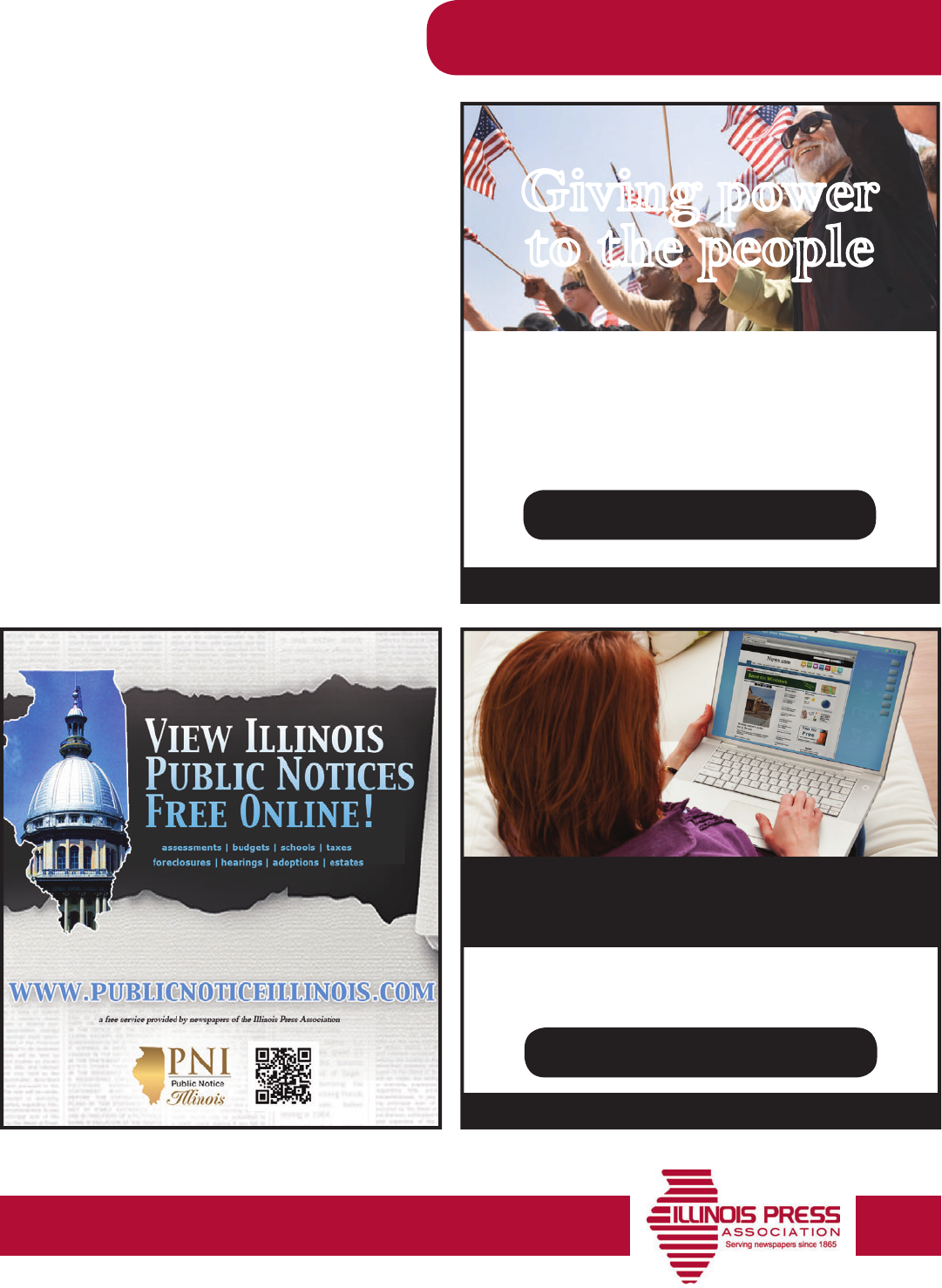
5
Best Practices and Resource Guide
Best Practices – Promotion
RUN HOUSE ADS
Newspapers typically run ads to promote many features of
what they do, but few newspapers run house ads about the
importance of public notices and the importance of newspapers
in providing that service.
The Illinois Press Association has house ads you can use. They
focus on public notices, as well as the public notice website,
PublicNoticeIllinois.com, which all public notices should be
uploaded to, according to state statute.
The ads are located at: www.illinoispress.org/PNIads
You can also nd public notice ads and more information for
your use at The Public Notice Resource Center’s website:
pnrc.net.
Giving power
to the people
Illinois Governments
keeping you informed
To know more, read public notices
in today’s newspaper or go to
PublicNoticeIllinois.com
Brought to you by your newspaper and the Illinois Press Association
Illinois’ business
is YOUR business
To know more, read public notices
in today’s newspaper or go to
PublicNoticeIllinois.com
Brought to you by your newspaper and the Illinois Press Association
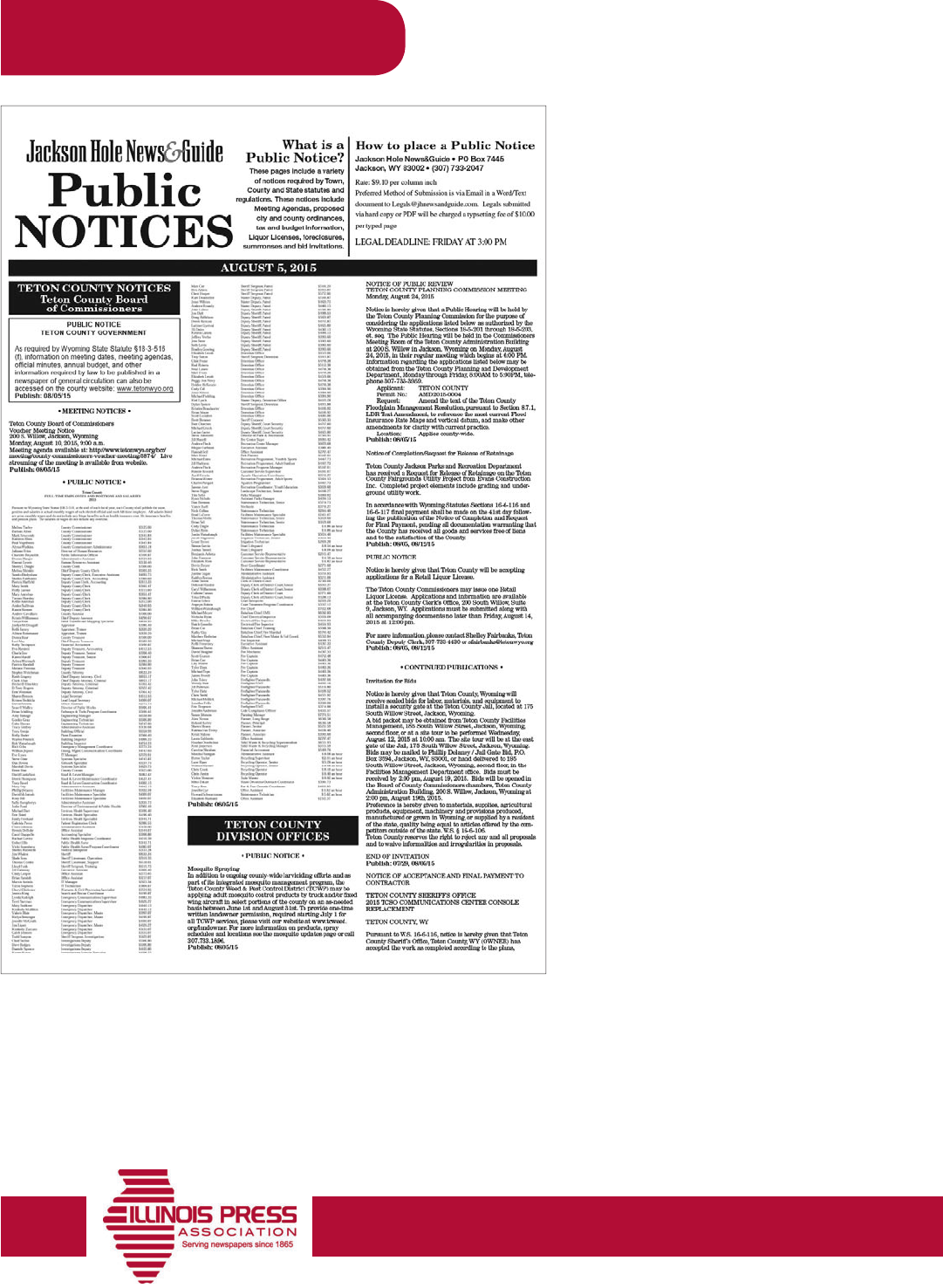
6
Best Practices and Resource Guide
MAKE THE PUBLIC NOTICE PAGES MORE
READER FRIENDLY
For many newspapers, legal notices are buried
underneath the classied section with little thought.
You’re also bound to certain state regulations on what
you can do to make them more reader friendly, but
that doesn’t mean you can’t make them stand out and
signify their importance.
To the left is an image of the legal page of the Jackson
Hole News & Guide in Wyoming. The public notice page
has its own section front, as well as information about
public notices at the very top. The text reads:
What is a Public Notice?
These pages include a variety of notices required by
city, county and state statutes and regulations. These
notices include meeting agendas, proposed city and
county ordinances, tax and budget information, liquor
licenses, foreclosures, summonses and bid invitations.
We recommend doing something similar.
TEASE YOUR LEGAL SECTION ON THE
FRONT PAGE
Is there something of great interest in the legals
section? Tease it. Send people to the section, and show
that you, as the publisher/editor, nd such value in the
content of legals that you’re placing it on Page 1.
USE THEM IN STORIES
Make sure reporters and editors are going through the legals. There are stories in there. And when they write the stories, don’t be afraid
to say where the information was found.
Best Practices – Print

7
Best Practices and Resource Guide
Best Practices – Print
LEARNING FROM THE MASTER: HOW JIM LOCKWOOD WEAVES AWARDWINNING JOURNALISM OUT OF PUBLIC
NOTICES
Public notice journalism is an art, according to Jim Lockwood, award-winning city government reporter for the Scranton (Pennsylvania)
Times-Tribune. But he promises that with practice, any reporter can become an expert in ferreting out important news articles from
public notices and keep readers in the know.
LOCKWOOD’S THREE Rs OF PUBLIC NOTICE JOURNALISM
1. Read them. They are right under your nose, in your own newspaper, and there is really no excuse not to read them.
2. Report on them. You will see something in public notices that will spark your curiosity. When that happens, dig a little deeper and
report on what you nd.
3. Reference them. Don’t be afraid to attribute information in your article to the public notice you are reporting on. Just treat it like any
other source and write, “according to a public notice published in this newspaper.” This type of attribution adds transparency to your
reporting and helps readers understand the importance of publishing notices in newspapers.
BE AN EARLY BIRD: Lockwood advises daily newspaper reporters to read their paper’s public notices rst thing in the morning.
Sometimes they announce meetings, hearings and other events and initiatives taking place that same day. “Don’t wait until 5 p.m. or
you might miss something important,” he said. Weekly newspaper reporters shouldn’t dally either.
PENETRATE THE LEGALESE: Often lawyers write public notices using legal terms, which can be hard for readers to comprehend.
“The more you read them, the better you’ll get at understanding them,” Lockwood says. “You’ll learn the patterns and you will be able to
get to the point quicker.” Sometimes the “nut graph” that tells you what the notice is really about will be the third line from the bottom.
EXERCISE YOUR CURIOSITY: Sometimes getting good public notice stories comes from old-fashioned shoe-leather reporting.
Lockwood recalls seeing a notice advertising a hearing on condemned and abandoned property, which consisted of two boats and a trailer.
It listed the date and time for the sale at the county courthouse and nothing else. His curiosity piqued, he dug a little deeper and discovered
the notice was a poorly-worded announcement that someone had a tax lien and had been required to liquidate their boat and trailer.
WHERE TO LOOK FOR PUBLIC NOTICES: Your own newspaper is a good source for public notices, but if your paper is not the
newspaper of record in your town or if other newspapers in your city or county run notices, then turn to them. Often public notices are
required to be posted at the courthouse or town hall and you can read them there as well. Another resource is the national public notice
directory, accessible at http://www.pnrc.net/nd-a-notice/
“When you read public notices, ask yourself, ‘What is going on here? What is the real story?’” Lockwood says. “Keep pulling away layers,
like an onion, and keep those layers stored away for reference.”
Some notices seem insignicant, but one thing might lead to another until you have an important story that can be spun o into
columns, editorials and even award-winning journalism packages.
By Teri Saylor for the Public Notice Resource Center
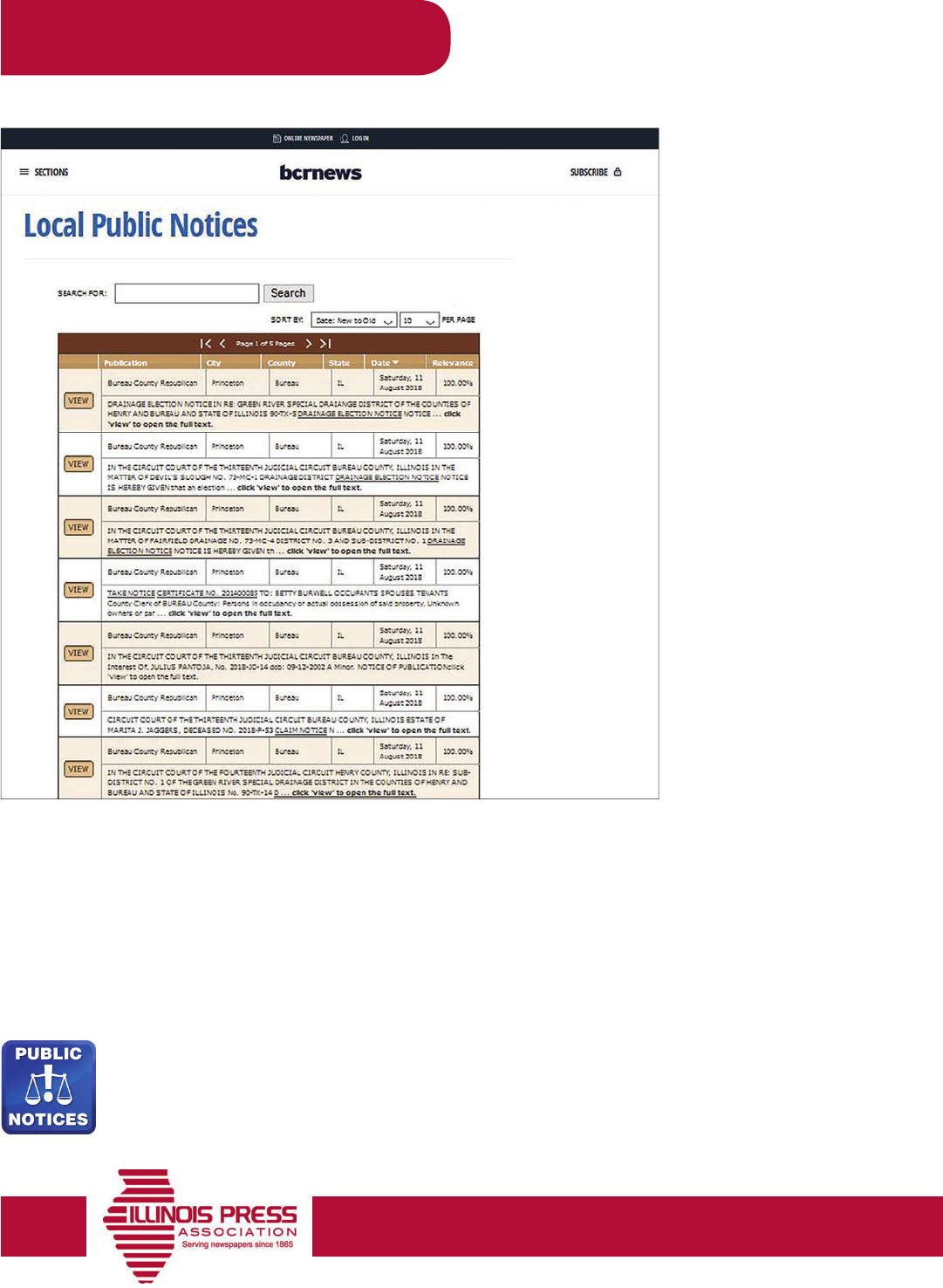
8
Best Practices and Resource Guide
Best Practices – Online
DON’T PLACE PUBLIC NOTICES
BEHIND A PAYWALL
On your news website, make public
notices easy to nd and easily
accessible. Many newspapers have
paywalls but don’t put classieds
behind the paywall.
We think the same should be true for
how you treat public notices.
FIND BETTER PLACEMENT FOR
PUBLIC NOTICES ON YOUR
WEBSITE
The majority of newspapers place
public notices as a sub category
of classieds. We recommend you
nd your own spot on the “toolbar”
of your website, or have your own
block dedicated to public notices. The
readership of public notices will likely
be higher.
DON’T HAVE THEM ON YOUR SITE?
1. Try the Iframe from PublicNoticeIllinois.com (example shown above), by simply inserting the ID for your publication found in the
newspaper admin portal on PNI. Utilize the following link: http://publicnoticeillinois.com/RecentNoticesByPubl.aspx?id=XXX
Simply replace XXX with your publication ID, embed this into the HTML code on your website and you now have your newspaper’s
notices embedded on your web page.
2. Utilize the hotlink
This image has been promoted as the icon for public notices from press associations around the country as a promotional tool
for public notice websites.

9
Best Practices and Resource Guide
Best Practices – Online
On your site you can link the hotlink image to: https://www.publicnoticeillinois.com/search.aspx?paperid=XXX for a direct link to your
notices on the PublicNoticeIllinois.com. Simply replace XXX with your publication ID (as found in the newspaper admin portal on PNI).
Be sure to share the hotlink with your county! Supply them with a direct link to the county’s notices on PNI, utilizing the following URL:
https://www.publicnoticeillinois.com/search.aspx?countyid=1
Contact the IPA for your county ID (the above example links to Adams County). Questions – contact Ron Kline (rkline@illinoispress.org)
or Kate Richardson (krichardson@illinoispress.org)
ENSURE YOU’RE UPLOADING THE FULL ISSUE OF YOUR NEWSPAPER TO FTP.IPAMEDIASERVICES.COM
In Illinois, we’ve made it easy for your notices to post on PublicNoticeIllinois.com. Just send us a PDF copy of each issue of your
newspaper on or before your publication day through ftp.ipamediaservices.com (or members may upload directly at illinoispress.org)
and we will clip and upload your notices for you! Email Kate Richardson (krichardson@illinoispress.org) for more details.
For newspapers that have the capability, direct feeds to PublicNoticeIllinois.com may be set up. The rst step is to reach out to your
database provider to ask about your options, or you may contact Ron Kline (rkline@illinoispress.org) for more information.
There are three main reasons you should upload to your paper to ftp.ipamediaservices.com so that we can upload your notices to
PublicNoticeIllinois.com.
1. It’s state law that all notices published are uploaded to the site, and you could lose your qualication and designation as a paper of
record by not doing so.
2. PNI creates a clearinghouse for all Illinois public notices, in addition to push notications, making it easier for the public to get
information through you, the third-party provider.
3. PublicNoticeIllinois.com helps us ght o attempts to have the government place legal notices on their websites. We already have
a public notice site, so there is no need for them to create one. If you don’t upload your newspaper to the IPA or send a direct feed, it
hurts our claim that we are the third-party system of record.

10
Best Practices and Resource Guide
Best Practices – Perspective
CHANGE THE ARGUMENT
When legals come under attack, it is almost always about how the government
entities could save money by not placing such notices in newspapers. The following
are some common claims made by government ocials and counter arguments.
CLAIM:
Placing legals online is a free option.
COUNTER ARGUMENT:
This is simply not true as it costs both the government and the public to place legals
online, and even more if the government were to upload to their own sites.
Costs for the government agency include: There is an employee(s) cost to upload.
There are website development costs. There are website maintenance costs. There
are internet costs.
Costs for the public include: There is a cost for computers. There is a cost for internet
access (if they have access). There is the cost of time to nd all the applicable government websites to nd the legal notices, which
ranges into thousands of websites that residents would have to search.
There is also the potential cost of litigation against public bodies that fail to give notice of pending government actions. Studies have
shown that this is a very real concern when considering public policy that allows government bodies to report on themselves.
Existing laws are already on the books in Illinois requiring certain information – things like meeting agendas and minutes – to be posted
and readily available on government websites. It’s the law. Yet a recent study by the Citizens Advocacy Center (CAC) for the Illinois Press
Association audited 385 public bodies with websites found that only 71.26 percent complied with posting an agenda, and only 73.87
percent with posting approved meeting minutes as required by the Open Meetings Act.
1
With PublicNoticeIllinois.com, all notices are in one location, at no cost to the public or the government. It is a public service to our
readers, powered by Illinois’ newspapers, because we believe in the public’s right to be aware of government activities.
It should be noted that PublicNoticeIllinois.com does not replace the value of having public notices/legals in a newspaper. The ocial
legal notice record-keeper is still the newspaper, since it provides third-party verication and a permanent record.
1. Illinois Press Association, 2018

11
Best Practices and Resource Guide
CLAIM:
We would rather use money for “vital” public services.
COUNTER ARGUMENT:
Government ocials need to know that providing transparency and accessibility to their current actions and/or records is, in fact, a vital
public service.
And newspapers have the greatest reach to provide that vital public service with the added benet of being a third-party entity, which
provides protection for government ocials from accusations, while also providing both a permanent record in the paper and online
access via PublicNoticeIllinois.com.
Furthermore, it would be wise to look at how much each government entity spends on public notices in your paper, and then compare
it to the overall government budget.
It’s easy for them to say it costs a certain amount that sounds big, but when put in context of a comparison to an overall budget, it’s a
small number to keep the public informed.
Best Practices – Perspective
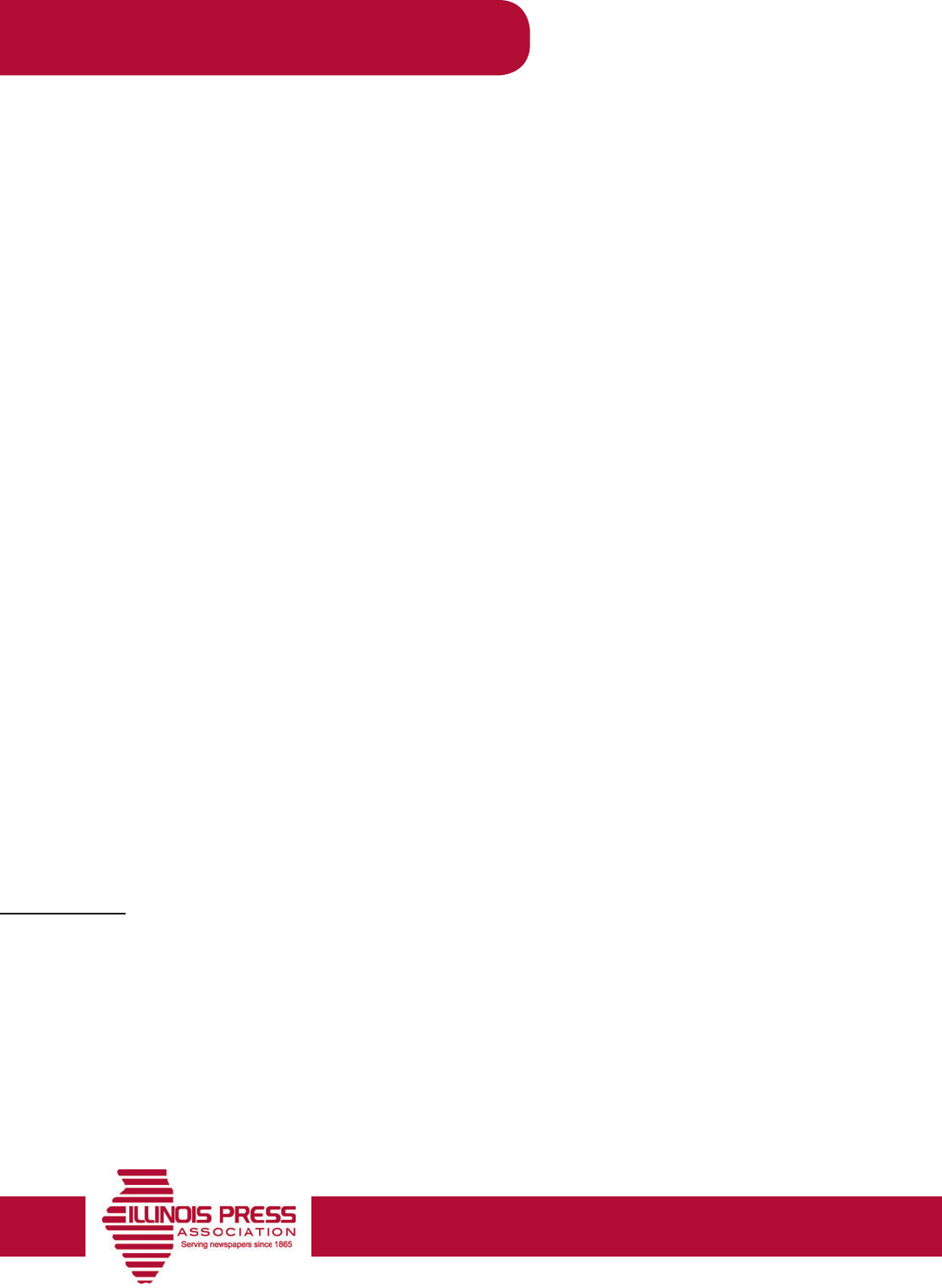
12
Best Practices and Resource Guide
Best Practices – Perspective
CLAIM:
With falling circulation, newspapers no longer make sense to house public notices.
COUNTER ARGUMENT:
When this argument is made, it is typically over exaggerated by the numbers.
For example, if you are meeting with a state senator or representative, and he or she were to claim that newspaper circulation is falling
and no one reads newspapers anymore, then there is an opportunity to inform and change the narrative.
According to a 2016 study by Nielsen Scarborough, “more than 169 million adults in the U.S. read a newspaper in a month—whether it
be in print, on a website or via mobile app. In total, newspapers reach 69 percent of the U.S. population in a given month.”
1
Additionally, many critics simply use circulation numbers, but fail to include average readership numbers. Further, this does not include
the website trac from online subscribers.
For instance, in 2017, the total yearly circulation of IPA member newspapers was 482.2 million, with approximately 353.7 million
coming from daily newspapers and 128.6 million coming from weekly newspapers.
2
And according to a 2018 study by the National
Newspaper Association, 69 percent of community newspaper readers share their newspaper with up to ve other people.
3
Taking this
into account, we can see that circulation numbers alone do not tell the whole story of audience reach since most readers will end up
sharing their paper with friends, family and co-workers.
In addition, it should be noted that newspaper readers are some of the most civically engaged members of their community. Newspaper
subscribers are generally consistent voters and well-informed citizens. In the 2016 presidential election, 88 percent of community
newspaper readers voted, with 40 percent relying on their newspaper to help them decide about candidates and election issues.
4
1. Nielsen Scarborough, 2016
2. Illinois Press Association, 2017
3. National Newspaper Association, 2018
4. National Newspaper Association, 2017
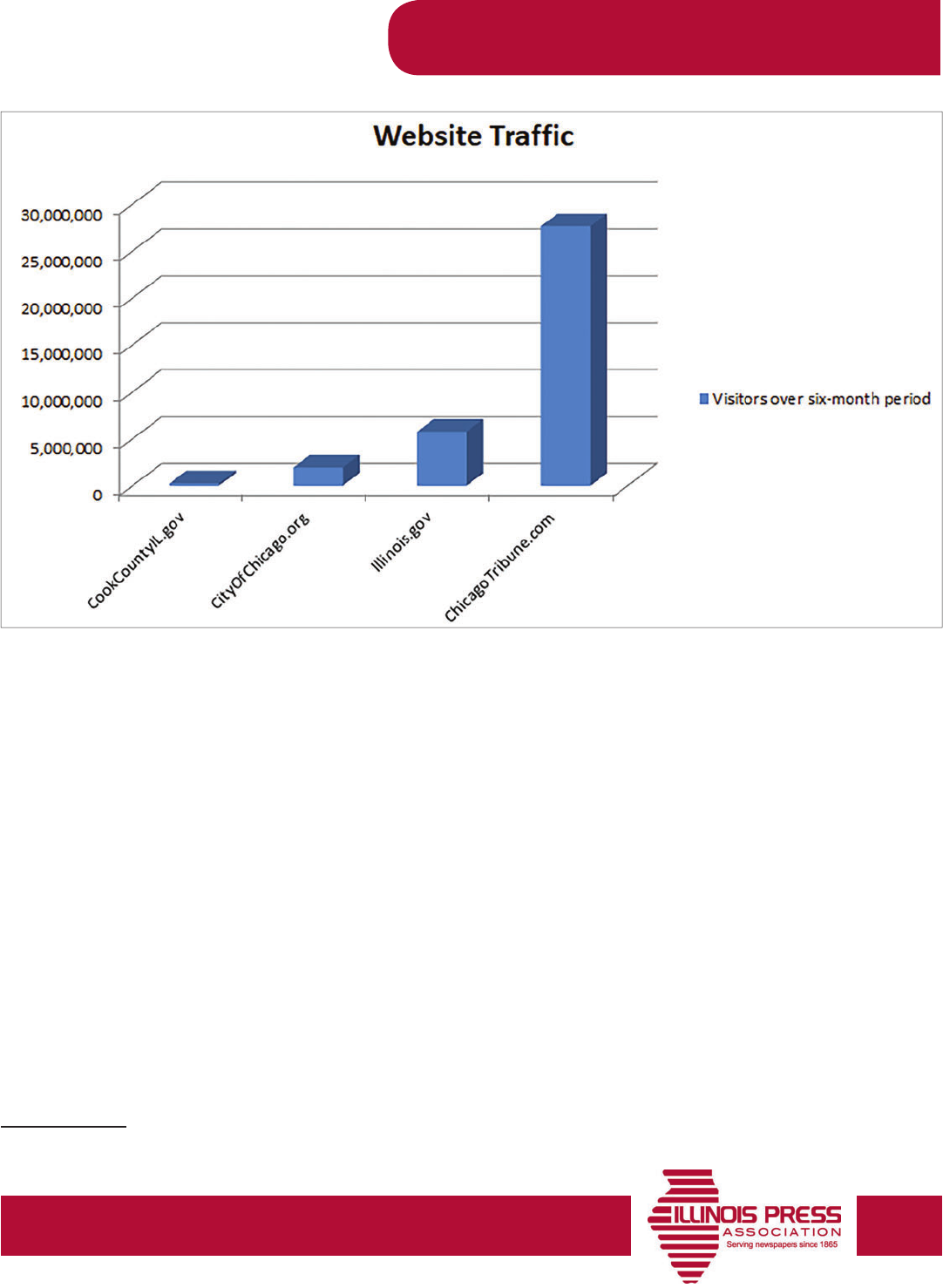
13
Best Practices and Resource Guide
And there is more …
Circulation does not factor in online readership of Illinois’ newspapers. Most newspapers also post legals to their sites. For example, look
at ChicagoTribune.com. For a six-month period, it had nearly 28 million total visits, according to Similarweb.com, which is 378.7 percent
more than Illinois.gov for the same period. CookCountyIL.gov does not boast better results. CookCountyIL.gov only had 265.46 thousand
views during that six-month period. That is 10,323 percent less than the Chicago Tribune’s website.
1
When you talk about actual readership of newspapers both in print and online, newspaper organizations easily have the state’s 12.8
million population covered.
In short, no information medium reaches more people than newspapers and their professionally operated websites.
It also does not factor in that PublicNoticeIllinois.com creates a clearinghouse for all public notices. So, government ocials are getting
the value and reach of public notices being in newspapers, the third-party verication and permanent record, and those government
entities are also getting a one-stop shop for the public for all legal notices at no extra cost.
1. SimilarWeb, 2018
Best Practices – Perspective

14
Best Practices and Resource Guide
Best Practices – Talking points
WHY PUBLIC NOTICES ON GOVERNMENT WEBSITES IS A BAD IDEA
• Overall, any internet notice is an inadequate substitute for a printed, xed newspaper notice, although the IPA believes the internet
can be actively used by newspapers to extend the reach of printed notices. The newspaper industry has already made substantial
investments in making sure public notices are available through industry websites, so the public can nd notices both in print and
online without losing the many advantages of a xed, hard-copy notice.
• While Illinois’ Open Meetings Act requires that a public body maintain basic information regarding notices of public meetings, public
meeting agendas, and approved minutes from public meetings on its website, the Illinois Press Association with the Citizen Advocacy
Center found that of the surveyed public bodies, only 51 percent bother to maintain a website.
1
• Based on the CAC’s overall survey of 825 total public bodies and 419 public bodies with websites, the compliance rate for posting
notice, an agenda, or approved meeting minutes was mediocre at best. Of the 419 public bodies with websites, compliance was 90.93
percent with posting notice, 71.12 percent with posting an agenda, and 73.75 percent with posting approved meeting minutes within
the provisions of OMA. For those public bodies with at least one full-time sta member, compliance was 93.56 percent for posting
notice, 75.74 percent for posting an agenda, 77.23 percent for posting approved meeting minutes, and 76.24 percent for posting a
means of electronic communication.
• When public bodies are not forced by law to publish notices in newspaper, as the CAC data shows, the compliance rates are not
perfect. When looking at lower population areas, the compliance rates fall even more, with most being below 50 percent for posting
agendas and meeting minutes.
• Proposals to eliminate newspaper notices fail to address the fact that local newspapers still have a much broader regular readership
than almost all government websites. Although the public conversation about newspapers tends to focus on the shift to digital,
newspaper readership in small communities is especially strong; 64 percent of adults in such communities read a community
newspaper. Of those readers, 46 percent say newspapers and their websites are their primary source of information.
2
• Access to the internet remains limited. A 2017 report by the U.S. Census Bureau reported that in 2015, 23 percent of citizens did not
have a broadband internet subscription. This number grows to 38 percent when considering households headed by a person aged
65 and older. Additionally, many in the Midwest (24 percent) cannot readily view internet notications due to a lack of internet
subscription.
3
The Federal Reserve Bank of Minneapolis reported in 2017 that 53 percent of American households and 55 percent of
Illinois households are not connected to high speed internet.
4
1. Illinois Press Association, 2018
2. National Newspaper Association, 2018
3. U.S. Census Bureau, 2017
4. Federal Reserve Bank of Minneapolis, 2017

15
Best Practices and Resource Guide
• Internet site-only notications create due process problems for reviewing courts, historians, researchers and archivists. Web
publications are dicult to archive and maintain in an updated fashion without ongoing funding, whereas a printed public notice is
xed in form and time and leaves no doubt as to its authenticity.
• Government entities have no way to ensure there will be appropriated adequate resources to maintain notices in a digital fashion that
permits them to supplement printed, xed notices. Indeed, the president has already eliminated many federal government websites
for budget reasons.
NEWSPAPERS ENSURE GOVERNMENT ACCOUNTABILITY
• Newspapers guard government accountability by acting as an independent third-party. Government ocials must ensure that the
actions of the government are transparent to the general public. Publication of public notices in newspapers, independent third-
parties, helps conrm that the government is accountable to the electorate. When a newspaper publishes a notice, it veries that the
government has provided proper notice to the public. Moving public notices solely to government websites will remove this important
audit role.
• Public notices in newspapers reach the vast majority of Americans. Unlike newspapers, government websites do not reach passive
information seekers. Moving public notices to government websites would require that citizens actively search these sites looking
for public notices. Public notices in newspapers, on the other hand, reach those readers who are not likely to have the time or
inclination to search government websites for public notices. This is bolstered by the fact that “more than 169 million adults in the
U.S. read a newspaper in a month—whether it be in print, on a website or via mobile app. In total, newspapers reach 69 percent
of the U.S. population in a given month.”
1
If government websites have the same audience reach as newspapers, the data has not
been presented. Newspapers that publish public notices are required by state and local governments to demonstrate readership by
providing a list of paid subscribers, submitting to outside subscription audits or maintaining postal permits.
• Government websites do not provide legal adavits and written proof of publication and a secure and veriable paper trail. State
and local governments, attorneys and private citizens rely on this documentation to ensure that these notices were published timely
and lawfully, as newspapers are required by law to do. Illinois Case Law acknowledges printed legal notices as legal documentation in
court.
1. Nielsen Scarborough, 2016
Best Practices – Talking points
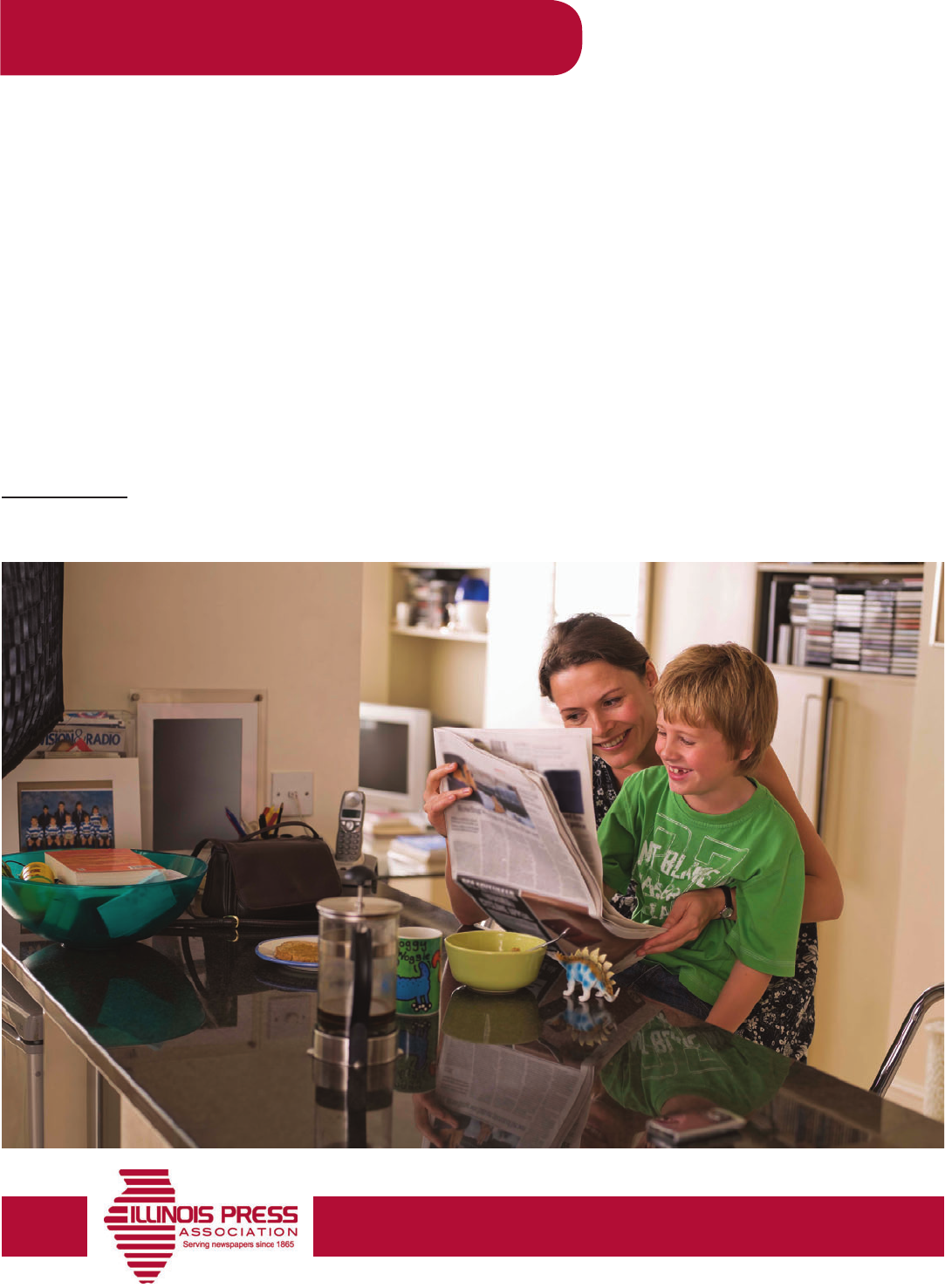
16
Best Practices and Resource Guide
Best Practices – Talking points
• It is extremely costly for government agencies to create, maintain and secure websites in order to publish public
notices. State and local governments will have to pay consultants or undertake the massive process internally to develop, maintain,
and most importantly, secure websites for the distribution of public notices. Securing websites so that public notices are not altered
or deleted by hackers will be the biggest expense facing state and local governments. With publication in printed newspapers,
government ocials do not have to worry that hackers will put into question whether the public was informed on important public
issues.
• Publishing public notices on government websites would put seniors, minorities and the disabled at a disadvantage.
If public notices are moved to government websites, state and local governments will have diculty notifying senior citizens and
minorities of actions in the public interest. The U.S. Census Bureau reported that in 2015 that 37 percent of senior citizens (65+ years)
do not have access to the internet at home, with blacks at 35 percent and Hispanics at 29 percent.
1
1. U.S. Census Bureau, 2017

17
Best Practices and Resource Guide
The law
In order to protect the integrity of the industry and the public notice process, it is important for all members to know what constitutes
a legal newspaper and what to check for in order to make sure that their newspaper is meeting these requirements. Any question as to
whether or not your newspaper is correctly following these guidelines should be directed to the Illinois Press Association Government
Relations sta.
The following items are taken from the Illinois Compiled Statutes, Chapter 715 section 10, the Newspaper Legal Notice Act.
Your publication MUST meet all these requirements in order to be considered a newspaper by Illinois law, and therefore able to publish
legal notices. Each of the following letters corresponds to its subsection in the Newspaper Legal Notice Act.
PAGE AND COLUMN SIZE REQUIREMENTS
(A) A newspaper MUST “consist of not less than four pages printed matter and contains at least 100 square inches of printed matter per
page.” If you are unsure of the size of your paper, measure the dimensions of the columns with a ruler. This requirement does not refer to
the size of the physical paper, but rather the size of the column of print.
PRINTING REQUIREMENTS
(B) To be considered a legal newspaper, the newspaper MUST be printed, “using a conventional and generally recognized printing
process such as letterpress, lithography, or gravure.”
CONTENT REQUIREMENTS
(C) A newspaper MUST “annually average at least 25 percent news content per issue or annually average at least 1,000 column inches of
news content per issue. News content is dened as any printed matter other than advertising.”
(D) A newspaper MUST ”publish miscellaneous reading matter, legal, or other announcements and notices, and news and information
concerning current happenings and passing of events of a political, social, religious, commercial, nancial, or legal nature, and
advertisements or bulletins.”
Resources – Law

18
Best Practices and Resource Guide
Resources – Law
INTERVAL REQUIREMENTS
(E) A newspaper MUST be published at regular intervals; therefore a legal newspaper is a paper, “which has been continuously
published at regular intervals of at least once each week with a minimum of 50 issues per year, for at least one year prior to the rst
publication of the notice; or which is a successor to a newspaper as herein dened with no interruption of publication of more than
30 days; or which is a merged or consolidated newspaper formed by the merger or consolidation of two or more newspapers, one of
which has been continuously published at regular intervals of at least once each week with a minimum of 50 issues per year for at least
one year prior to the rst publication of the notice. A newspaper shall be considered as continuously or regularly published although
its publication has been suspended, where such suspension was caused by re or an Act of God or by a labor dispute or by its owner,
publisher, managing editor or other essential employee entering the active military service of the United States, if the newspaper was
continuously or regularly published for at least one year prior to its suspension and if its publication is resumed at any time not later
than 12 months after such re or Act of God, or if its publication is resumed at any time within 12 months after the termination of the
labor dispute, or if its publication is resumed at any time within 12 months after the termination of the war in connection with which
such persons entered such military service.”
PUBLIC NOTICE ILLINOIS REQUIREMENT
(F) A newspaper must have “the capability of placing, at no additional cost to government, notices required pursuant to this Act on a
daily or weekly basis on the statewide website established and maintained as a joint venture by the majority of Illinois newspapers as a
repository for such notices.”
Please do not hesitate to contact the IPA Government Relations team with questions regarding your newspaper. The IPA strives to
protect the integrity of public notices.

19
Best Practices and Resource Guide
Qualications
WHAT ARE QUALIFICATIONS OF A LEGAL NEWSPAPER?
(Illinois Compiled Statutes, Chapter 715 section 10, the Newspaper Legal Notice Act)
1. MUST BE PUBLISHED AT LEAST WEEKLY
REASON: Publications need to run a minimum 50 out of 52 weeks a year per the law. The reasoning is that notices should be in
publications that publish frequently and at regular intervals so the government can provide timely notice and that the public can
consistently nd the notices.
2. MUST MEET THE REQUIREMENTS IN STATUTE OF BEING PUBLISHED IN OR CIRCULATED IN THE AREA IN
WHICH THE NOTICE OR ADVERTISEMENT IS REQUIRED.
REASON: Notices may be required to be published in a certain area to qualify for the notice. For example, a school district notice
may require the newspaper be published in the school district in order to run the notice. Other notices may require a newspaper
simply circulate in the municipality or area the notice is required. The principle is that notices should not be hidden in some faraway
publication, but as close to the aected parties as possible. The language in the Illinois Compiled Statutes will clearly say where the
notice must run (published in or circulated in). If you are uncertain if you should run a notice, please call the IPA Government Relations
sta.
3. MUST HAVE BEEN PUBLISHED AT LEAST 52 CONSECUTIVE WEEKS UNINTERRUPTED AND CONTINUOUSLY
PRIOR TO PUBLISHING FIRST NOTICE.
REASON: This language assures that the publication has community support and is a reliable, timely publication that can complete a
notice’s publication term.
Resources – Law
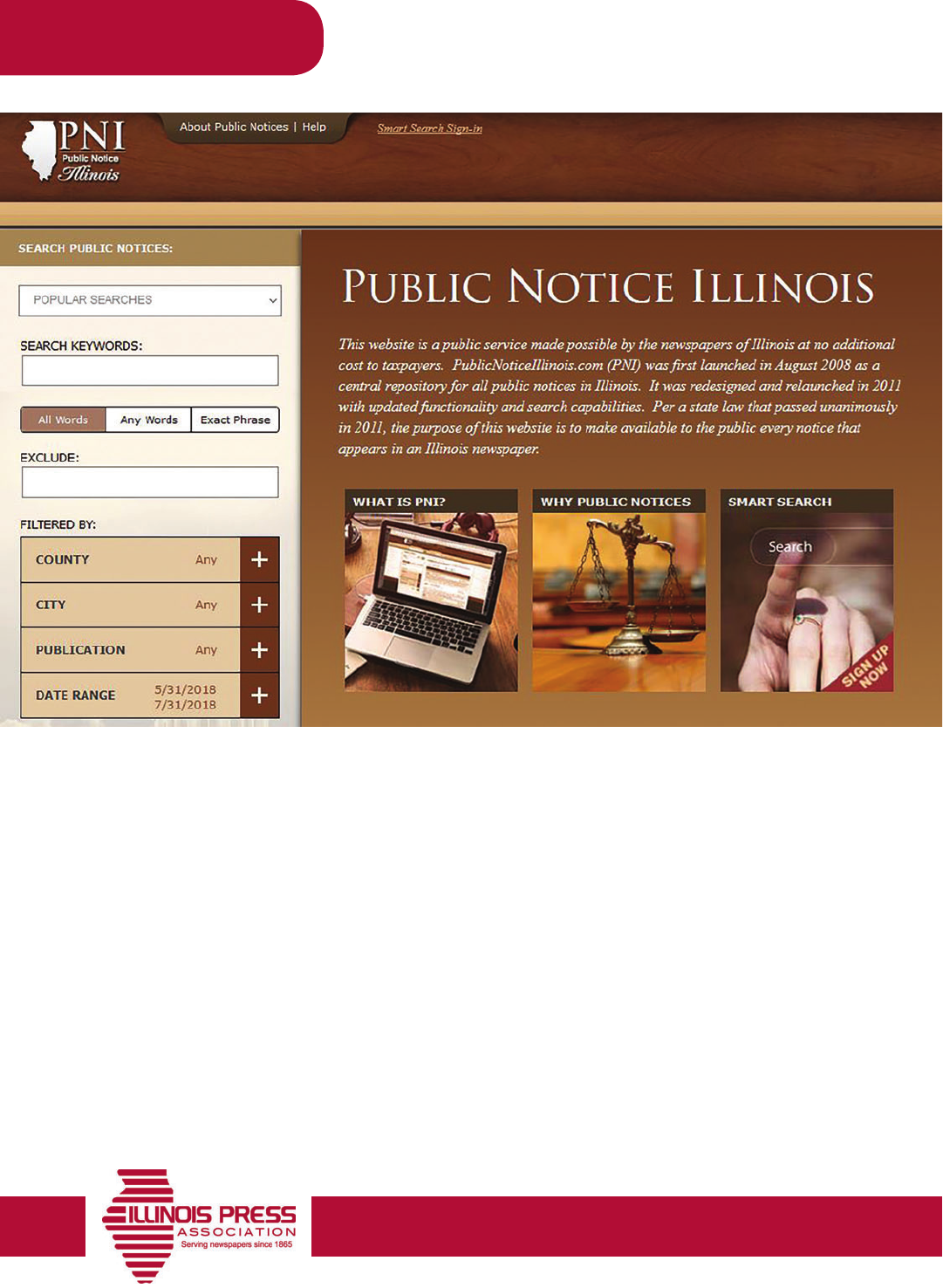
20
Best Practices and Resource Guide
Resources – Law
4. MUST UPLOAD LEGAL NOTICES TO PUBLICNOTICEILLINOIS.COM AT NO ADDITIONAL COST TO THE PERSON OR
ENTITY PLACING THE NOTICE.
REASON: Newspapers agree that public notices should be on the internet. That’s why the IPA supported legislation in 2010 that
became law in 2013 (P.A. 96-1144), which requires every newspaper to post all public notices on a centralized, statewide website
at no additional cost to government. That website, PublicNoticeIllinois.com, is the sole online location for every public notice
published in the state of Illinois. Allowing the government agencies to post public notices on its own website means that this
information would no longer be available on PublicNoticeIllinois.com, thereby going against the General Assembly’s intent of
having all notice information located in one searchable online database. With this statute, the print product of the newspapers still
remains the ocial public notice, but also creates a clearing house for all public notices in the state.

21
Best Practices and Resource Guide
FAQs
WHO DETERMINES WHAT NOTICE MUST BE GIVEN?
The Illinois Compiled Statutes have set the standards for public notice by governmental entities, and the courts have set standards for
notice to individuals who need to be warned of actions about to be taken against them. Since roughly 7,000 governmental entities
exist, logic dictates that basic references to public notice should be collected within a single source, the Illinois Compiled Statutes, and
determined by a single body, the state Legislature.
Public notice has been an integral part of the Illinois Compiled Statutes since statehood because it serves several purposes:
• Public notice requires the governmental entity to tell when hearings are to be held, how money is being spent, what laws are being
passed, what property is being sold, etc.
• Public notice provides a permanent record of actions that are taken and a legally defensible notication of actions about to be taken.
• Public notice is the ONLY way that exact wording can be provided by the entity’s counsel.
Resources – FAQs

22
Best Practices and Resource Guide
Resources – FAQs
WHY ARE NEWSPAPERS USED?
The General Assembly has also set standards for the communication of public notices. To ensure that every citizen has an equal
opportunity to access public notice, legislators chose newspapers. Newspapers have two attributes which contributed to this decision:
Verbatim text, the legal language necessary to provide total public notice, can be spread most easily among members of the public by a
compact written notice which can be studied at length, preserved in a home or oce, and collected for future reference in a repository
outside the jurisdiction of the local government, a newspaper’s archives.
Selection of a source for publication outside the government provides a second-party witness to the fact that the public has been
informed of this important information.
HOW ARE LEGAL NOTICES BILLED?
Assessments (35 ILCS 200/12-15)
The price for publishing assessments is now set statewide (not including Cook County) at a at rate of 80 cents per-parcel. The per-
parcel price schedule (ranging from 80 cents to $2 per-parcel) has been eliminated. In Cook County, any newspaper publishing an
assessment list is entitled to a fee of 40 cents per column line for publishing such lists.
Delinquent Tax Lists (35 ILCS 200/21-117)
The cost for advertising delinquent lists, in all counties, for tracts of land, is 40 cents per column line. For town lots, in counties of the
rst and second class, it is 40 cents per column line and in counties of the third class, it is 50 cents per column line, to be taxed and
collected as costs. Most counties will be 40 cents per column line. It is also 40 cents per column line for the preamble, descriptive
readings, the adavit and any other matter accompanying the delinquent list.
All Other Notices (715 ILCS 15/1)
The maximum rate charged for each insertion of a required public notice shall not exceed the lowest classied rate paid by commercial
users for comparable space in the newspapers in which the required public notice appears and shall include all cash discounts, multiple
insertion discounts, and similar benets extended to the newspaper’s regular customers.

23
Best Practices and Resource Guide
What to charge?
HOW TO CHARGE FOR LEGAL NOTICES
For required public notices, Illinois sets the amount to be charged for assessments and delinquent tax lists; however, it does not set
the maximum rate for all other required public notices. For these other public notices, the Legal Advertising Rate Act (715 ILCS 15/1)
states that the minimum is 20 cents per column line for each insertion and maximum is not to exceed the lowest classied rate paid by
commercial users for comparable space. This includes all cash discounts, multiple insertion discounts, and similar benets extended to
the newspaper’s regular customers.
“Commercial users” means a customer submitting commercial advertising and does not include a customer submitting a required public notice.
HOW TO DETERMINE TYPE FACE SIZE
The face of type of any required public notice shall not be smaller than the body type used in the classied advertising in the newspaper
in which the required public notice is published. This is stated in the Legal Advertising Rate Act (715 ILCS 15/1).
Resources – FAQs

24
Best Practices and Resource Guide
Resources – Types
GOVERNMENT
CHAPTER 5 GENERAL PROVISIONS
CHAPTER 10 ELECTIONS
CHAPTER 15 EXECUTIVE OFFICERS
CHAPTER 20 EXECUTIVE BRANCH
CHAPTER 25 LEGISLATURE
CHAPTER 30 FINANCE
CHAPTER 35 REVENUE
CHAPTER 40 PENSIONS
CHAPTER 45 INTERSTATE COMPACTS
CHAPTER 50 LOCAL GOVERNMENT
CHAPTER 55 COUNTIES
CHAPTER 60 TOWNSHIPS
CHAPTER 65 MUNICIPALITIES
CHAPTER 70 SPECIAL DISTRICTS
CHAPTER 75 LIBRARIES
REGULATION
CHAPTER 205 FINANCIAL REGULATION
CHAPTER 210 HEALTH FACILITIES AND REGULATION
CHAPTER 215 INSURANCE
CHAPTER 220 UTILITIES
CHAPTER 225 PROFESSIONS, OCCUPATIONS, AND BUSINESS
OPERATIONS
CHAPTER 230 GAMING
CHAPTER 235 LIQUOR
CHAPTER 240 WAREHOUSES
EDUCATION
CHAPTER 105 SCHOOLS
CHAPTER 110 HIGHER EDUCATION
CHAPTER 115 EDUCATIONAL LABOR RELATIONS
HUMAN NEEDS
CHAPTER 305 PUBLIC AID
CHAPTER 310 HOUSING
CHAPTER 315 URBAN PROBLEMS
CHAPTER 320 AGING
CHAPTER 325 CHILDREN
CHAPTER 330 VETERANS AND SERVICE MEMBERS
HEALTH AND SAFETY
CHAPTER 405 MENTAL HEALTH AND DEVELOPMENTAL DISABILITIES
CHAPTER 410 PUBLIC HEALTH
CHAPTER 415 ENVIRONMENTAL SAFETY
CHAPTER 420 NUCLEAR SAFETY
CHAPTER 425 FIRE SAFETY
CHAPTER 430 PUBLIC SAFETY
AGRICULTURE AND CONSERVATION
CHAPTER 505 AGRICULTURE
CHAPTER 510 ANIMALS
CHAPTER 515 FISH
CHAPTER 520 WILDLIFE
CHAPTER 525 CONSERVATION
CONTINUED ON NEXT PAGE
Illinois Compiled
Statutes

25
Best Practices and Resource Guide
TRANSPORTATION
CHAPTER 605 ROADS AND BRIDGES
CHAPTER 610 RAILROADS
CHAPTER 615 WATERWAYS
CHAPTER 620 AIR TRANSPORTATION
CHAPTER 625 VEHICLES
CHAPTER 630 GENERAL TRANSPORTATION
RIGHTS AND REMEDIES
CHAPTER 705 COURTS
CHAPTER 710 ALTERNATIVE DISPUTE RESOLUTION
CHAPTER 715 NOTICES
CHAPTER 720 CRIMINAL OFFENSES
CHAPTER 725 CRIMINAL PROCEDURE
CHAPTER 730 CORRECTIONS
CHAPTER 735 CIVIL PROCEDURE
CHAPTER 740 CIVIL LIABILITIES
CHAPTER 745 CIVIL IMMUNITIES
CHAPTER 750 FAMILIES
CHAPTER 755 ESTATES
CHAPTER 760 TRUSTS AND FIDUCIARIES
CHAPTER 765 PROPERTY
CHAPTER 770 LIENS
CHAPTER 775 HUMAN RIGHTS
BUSINESS AND EMPLOYMENT
CHAPTER 805 BUSINESS ORGANIZATIONS
CHAPTER 810 COMMERCIAL CODE
CHAPTER 815 BUSINESS TRANSACTIONS
CHAPTER 820 EMPLOYMENT
Resources – Types
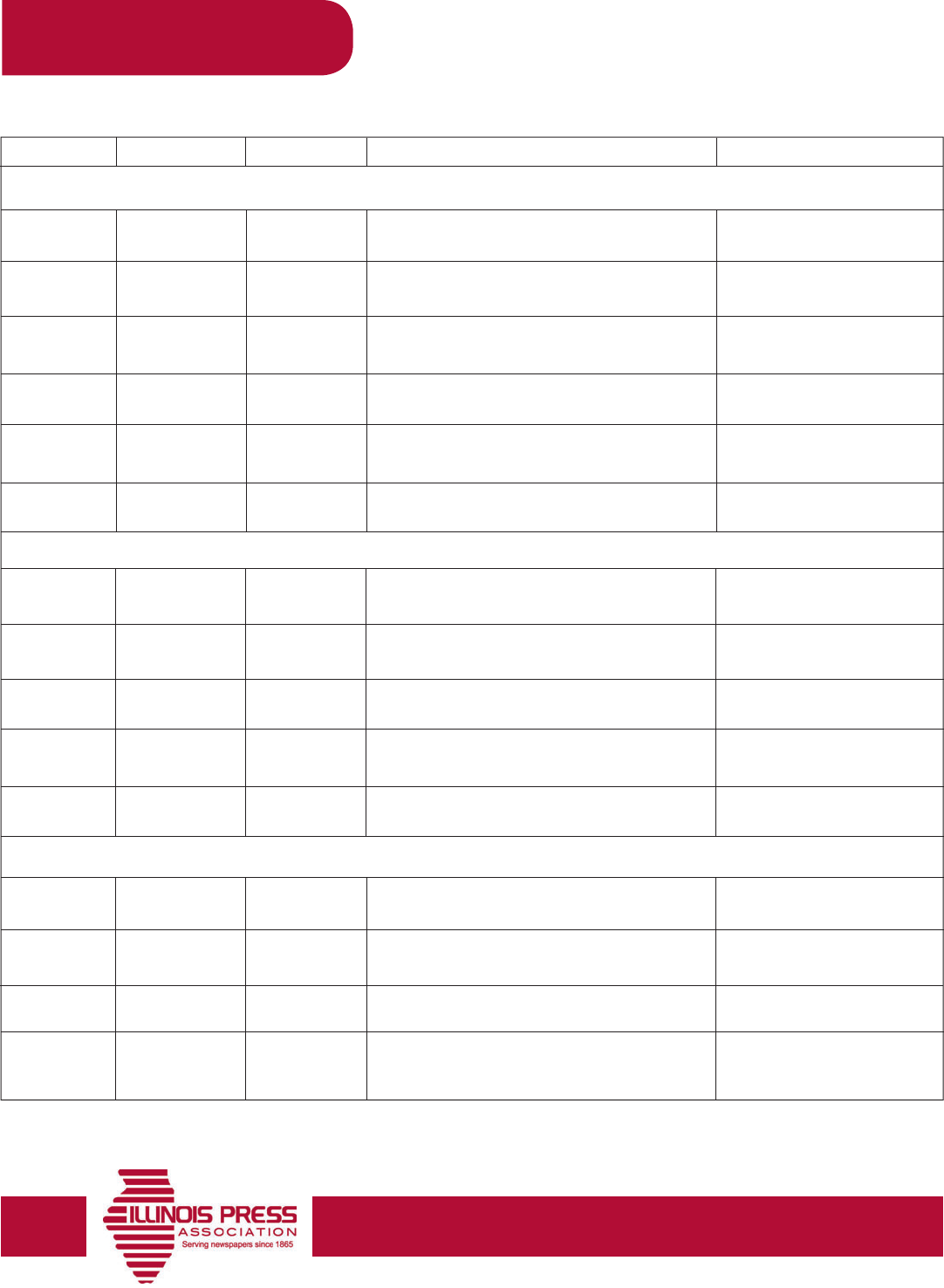
26
Best Practices and Resource Guide
Resources – Types
CONTINUED ON NEXT PAGE
WHAT
Elections
Budget/Fiscal
Financial
General
Public Funds
Receiver
Petitions, ordinances,
Resolutions
Property Disposal
Real Estate Sale
Primary
Candidates
School
Consolidated
State Procurement
Judicial Sale
List of Judges
Surplus Property
Notice
Polling Places
ENTITY
County
County, Muni, etc.
Bank
County
State
Bank
County
School
County
State
Bank
County
State
Bank
County
CITATION
10 ILCS 5/12-1
30 ILCS 15/2
205 ILCS 5/59
10 ILCS 5/28-2
30 ILCS 605/7
735 ILCS 5/12
10 ILCS 5/7-21
105 ILCS 5/10-17
10 ILCS 5/12-4
30 ILCS
500/40-20
735 ILCS 5/15
10 ILCS 5/16-10
30 ILCS 605/1.1
735 ILCS 5/21
10 ILCS 5/5-16.3
FREQUENCY
Once in two or more papers
Once, annually
Once a week for 12 consecutive weeks
Once
Once
Once a week for 3 successive weeks
Once in two or more papers
Once
Once
Once
Once
Once in two or more papers
Three
Once a week for 3 successive weeks
Once
EXPLANATION
Notice of general election at least 30 days before general
election
Public ocer scal year statement publication, within 6
months after the expiration of the scal year
Notice of appointing a receiver, upon ling of complaint
for dissolution
Petitions, resolutions, ordinances, back door referenda at
least 122 days and no more than 152 days prior to the vote
Disposition of transferable property sold to highest bidder,
at least seven days prior to sale
Notice of sale of real estate, three weeks before sale
Specimen ballots of each political party for primary ballots
at least 5 days prior to the general primary
Annual Statement of Aairs
Notice of consolidated and nonpartisan election not more
than 30 days or less than 10 days prior to the election
Notice of the request for information for availed real
property to lease in community where space is sought
Judicial Sale, rst notice not more than 45 days prior to the
sale; the last notice not less than 7 days prior to the sale
List of all nominations of judges of elections prior to the
day of the any election
Surplus real property held by the state, not less than 15
nor more than 30 days prior to sale
Notice by publication, upon application
Precinct registration notice includes date, hours, and
places at least 20 days prior to registration
COMMON NOTICES
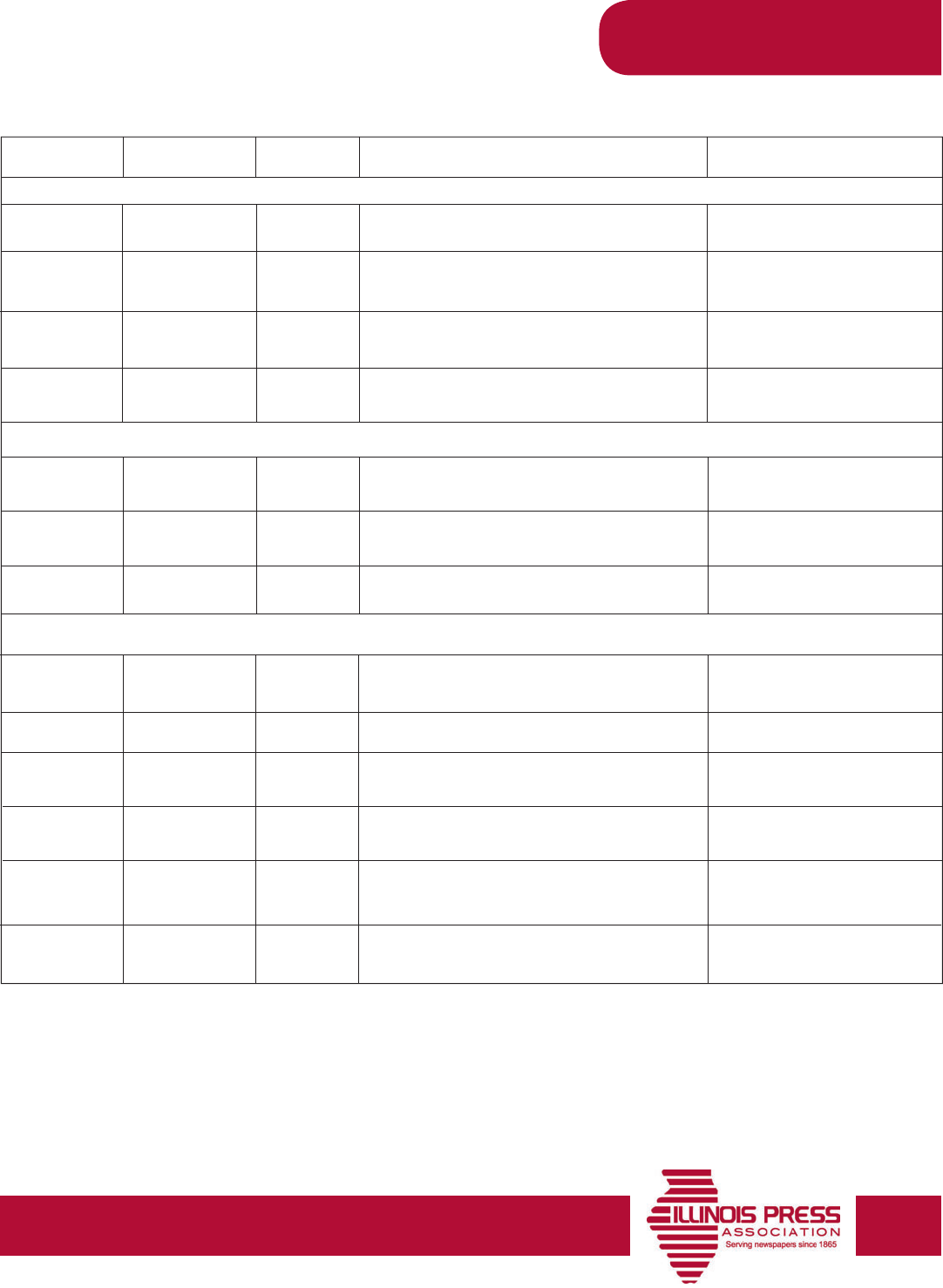
27
Best Practices and Resource Guide
WHAT
Bond Issues
Public Hearings
Other Frequent Publications
Bond Issue
Notication
Budget
Tree trimming
Capital Bonds
Budget
Adoption
Mechanics Lien
GO Bonds
Assess. Sup
Meeting
Divorce
Local Government
Debt Reform Act
Self Service
Name Change
ENTITY
County, Municipality
Municipality
Utility
State
School
Family
Business
State
County
Family
County, Municipality
Business
Individual
CITATION
30 ILCS 352/15
35 ILCS
200/23-35
220 ILCS
5/8-505.1
30 ILCS 420/6
105 ILCS 5/34
750 ILCS 50/7
770 ILCS 50/3
30 ILCS 330/11
35 ILCS
300/9-15
750 ILCS 5/410
30 ILCS 350/5
770 ILCS 95/4
735 ILCS
5/21-103
FREQUENCY
Once
Once
Once
Once in two or more daily newspapers;
one in Chicago and one in Springeld
Once
Once
Once if under $2,000 and 3 weeks if
over $2,000
Once in two or more daily newspapers;
one in Chicago & one in Springeld
Once
Once
Once
Once
Three successive weeks
EXPLANATION
Notice requirement for hearing for bond issuance, not less
than 7 days nor more than 30 days before hearing
Hearing on budget and appropriation ordinances, at least
30 days prior to time of hearing
Non-emergency vegetation management activities, not
less than 21 days before nor more than 90 days before
Sale of Capital Bonds by GOMB, at least 10 days prior to
opening bids
Two public hearings on budget, nal hearing on budget, 5
days and 2 days before respectively
Process for petition for adoption
Notice of sale publication information, dierent rules for
under $2,000 and over $2,000
Sale of Bonds by GOMB, at least 10 days prior to date of
opening bid
Annual meeting of supervisor of assessments, on or before
December 31
Dissolution – initiation of process
Backdoor referendum regarding issuance of bonds, must
be published before ling petitions
Enforcement of lien, sale or other disposition notice
Notice of name change
Resources – Types

28
Best Practices and Resource Guide
References
Federal Reserve Bank of Minneapolis (Aug. 15, 2017). Share of households subscribing to broadband internet service. Minneapolis,
MN: fedgazette. Retrieved from: https://minneapolisfed.org/publications/fedgazette/share-of-households-subscribing-to-
broadband-internet-service
Illinois Press Association (2018). DIGITAL BLACKOUT: Local government websites keep public in the dark. Elmhurst, IL: Citizen Advocacy
Center.
Illinois Press Association (2017). 2017 Membership Directory. Springeld, IL: Illinois Press Association
Illinois Press Association (2011). You said it, Illinois! Norman, OK: Newton Research.
National Newspaper Association (2018). 2018 Community Newspaper Readership Survey. Harrisburg, PA: Susquehanna Polling and
Research.
National Newspaper Association (2017). 2017 Community Newspaper Readership Survey. Harrisburg, PA: Susquehanna Polling and
Research.
Nielsen Scarborough (December 15, 2016). Newspapers Deliver Across the Ages. Retrieved from: http://www.nielsen.com/us/en/
insights/news/2016/newspapers-deliver-across-the-ages.html
SimilarWeb (2018). [Website trac statistics & market intelligence Aug. 3, 2018]. Data from chicagotribune.com, illinois.gov,
CookCountyIL.gov, cityofchicago.org. Retrieved from https://www.similarweb.com/website/chicagotribune.com, https://www.
similarweb.com/website/cookcountyil.gov#overview, https://www.similarweb.com/website/cityofchicago.org
U.S. Census Bureau (September 11, 2017). Computer and Internet Use in the United States: 2015. Retrieved from: https://www.census.
gov/programs-surveys/acs/library/publications-and-working-papers/reports.2017.html
